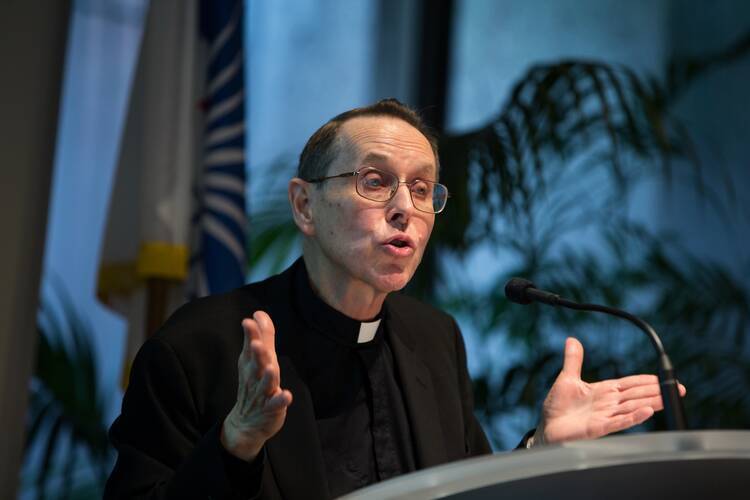On the last day of his life, Pope John Paul I, the smiling pope whose pontificate lasted only 33 days, said to Cardinal Bernard Gantin, the dean of the college of cardinals: “It is Jesus Christ alone we must present to the world. Outside of this we have no reason to exist.” As an outstanding student of the Gospels, the Rev. John Meier set himself to present the historical Jesus to the world, producing in five volumes one of the longest works ever published on this “marginal Jew.” The first volume came out in 1991. As the years slipped by, completing the research and writing required by this project became John’s central reason to exist.
It is not difficult to pile up public reasons why biblical scholars and a wider public remember John Meier with deep gratitude.
Becoming a member of the Catholic Biblical Association in 1971, John displayed the learning that made him the dean of “Jesus research.” He wrote “Jesus,” a key article for the New Jerome Biblical Commentary (1990), as well as a now-classic commentary on the Gospel of Matthew in 1980. He served for three years as editor of the Catholic Biblical Quarterly (1985–88) and also served as president of the Catholic Biblical Association (1991–92). John wanted high standards in his field of study, and this pushed him into joining Raymond E. Brown, S.S., and others in exposing and rejecting the pseudo-scholarship of the Jesus Seminar. Using skeptical principles and often relying on later sources, this group denied or doubted many of the sayings and doings of Jesus that historians of the Gospels would normally accept as authentic.
It is not difficult to pile up public reasons why biblical scholars and a wider public remember John Meier with deep gratitude. I would like to add something from my personal debt to John.
Over many years I taught classes, ran seminars, directed theses and published books and articles in the area of Christology—essentially asking “Who is Jesus in himself (in se)and what has he done for us (pro nobis)?” This activity also involved studying his resurrection from the dead. In 1967, I published an article in the Heythrop Journal, “Is the Resurrection an Historical Event?” John took it up with flattering approval, even if he did not necessarily agree with everything I had written.
The first volume of A Marginal Jew showed John accepting the embargo that the Scripture scholar Joseph Fitzmyer, S.J., had imposed on saying anything at all about the “interior” life of Jesus. Father Fitzmyer feared and rightly rejected attempts to psychoanalyze Jesus. But knowing and modestly claiming to know something about Jesus’ intentions is not claiming to know everything. The choice is not between all or nothing—between claiming to know everything and refusing to make any claims at all about Jesus’ intentions. Despite his alleged adherence to Father Fitzmyer’s embargo, John settled down to apply to Jesus the language of intending and deciding. Evidence from the Gospels at times supports conclusions about what went on in Jesus’ mind and heart.
John Meier taught me a great deal about the Beatitudes and Jesus’ preaching of the divine Kingdom.
John taught me a great deal about the Beatitudes and Jesus’ preaching of the divine Kingdom. In what I taught and wrote, I also picked up from John insightful ways of presenting the healing miracles of Jesus.
In particular, you learn more by taking together Mark’s story of a paralytic being healed by Jesus (Mk 2:1–12) and that of a lame man healed on a sabbath (Jn 5:1–18). Comparing and contrasting the stories of these two cures, as John Meier encouraged me to do, lets us glimpse their individual profiles and avoid the temptation to take them as simply two versions of the one tradition. Moreover, such detailed examination brings out the vivid, specific and seemingly eyewitness quality of the accounts. In both cases, albeit differently, the good that Jesus does prompts opposition, even murderous opposition. Dark shadows fall over his loving activity for others.
John’s scholarship also led me to examine comparatively two healings in a synagogue (Mk 3:1–6 and Lk 13:10–17) and two healings of lepers (Mk 1:40–45 and Lk 17:11–19). Once again the similarities and differences brought enriching insights into the ministry of Jesus and its impact today. I owe much personally to what John Meier wrote about the historical Jesus. By enhancing what could be learned from the great commentaries on the Gospels currently available, John put me in his debt forever.
May he rest in peace and rise in glory.








